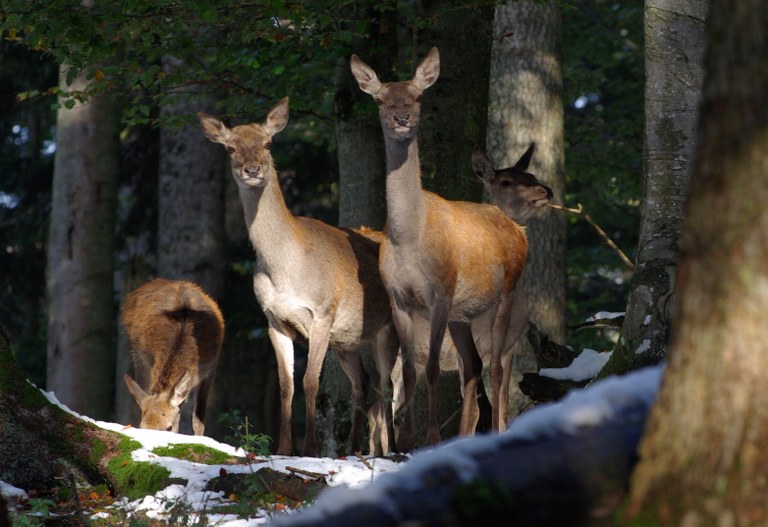Red deer populations in Europe: more influenced by humans than by wolves and other predators
Freiburg, Jan 10, 2024
Alongside the occasional bison and elk, red deer are Europe's largest native wild animal. An international study led by wildlife ecologists from the University of Freiburg has now investigated the factors that affect the red deer population in a particular area. The researchers were able to show that the population density of the animals in Europe is primarily influenced by human hunting and land use and not by large predators such as wolves, lynx and brown bears. “While large carnivores are often considered key factors in controlling prey populations in undisturbed ecosystems, this is less visible in human-dominated landscapes. Our study illustrates that these interactions are context-dependent,” says Dr. Suzanne T. S. van Beeck Calkoen, former PhD student at the Chair of Wildlife Ecology and Management at the University of Freiburg and first author of the study.

Herd of red deer (Photo: Rainer Simonis)
The researchers collected data on the population density of red deer at over 492 study sites in 28 European countries and analysed the influence of various factors such as habitat productivity, the presence of large carnivores, human activities, climatic variables and the protection status of the area. The evaluation of the data showed that human hunting reduced red deer density more than the presence of all large carnivores. Human land use, on the other hand, led to an increase in red deer density. In most cases, the presence of large carnivores had no statistically significant effect on the red deer population. Only when the three predators wolf, lynx and bear occurred together in one area did the number of red deer decrease. However, the study published in the Journal of Applied Ecology did not investigate how the presence of predators affects the behavior of red deer.
The return of the wolf
The study also sheds new light on the ongoing debate about the return of the wolf to Central Europe, notes Prof. Dr. Marco Heurich, Professor of Wildlife Ecology and Conservation Biology at the Faculty of Environment and Natural Resources at the University of Freiburg and initiator of the study. “Our research shows that the return of a large carnivore such as the wolf alone does not have a major impact on the occurrence of red deer. This is because in Central Europe, human influences predominate both indirectly through interventions in the red deer’s habitat and directly through the killing of the animals.” In addition, the mortality rate of wolves in Central European landscapes is very high, mainly due to road traffic, which further limits their influence on prey populations. “However, we also found a high variability in red deer densities, which indicates that there may be specific situations in which large carnivores do have an impact. Investigating this will be the task of future studies,” states Heurich.
- Original publication: Suzanne T. S. van Beeck Calkoen, Dries P. J. Kuijper, Marco Apollonio, Lena Blondel, Carsten F. Dormann, Ilse Storch, Marco Heurich: “Numerical top-down effects on red deer (Cervus elaphus) are mainly shaped by humans rather than large carnivores across Europe.” In: Journal of Applied Ecology (2023). DOI: 10.1111/1365-2664.14526
- Prof. Dr. Marco Heurich is Professor of Wildlife Ecology and Conservation Biology at the University of Freiburg
- Dr. Suzanne T. S. van Beeck Calkoen completed her doctorate at the Chair of Wildlife Ecology and Management at the University of Freiburg. She is a research associate at the University of Göttingen and the Technical University of Dresden.
Contact:
Office of University and Science Communications
University of Freiburg
Tel.: 0761/203-4302
e-mail: kommunikation@zv.uni-freiburg.de

